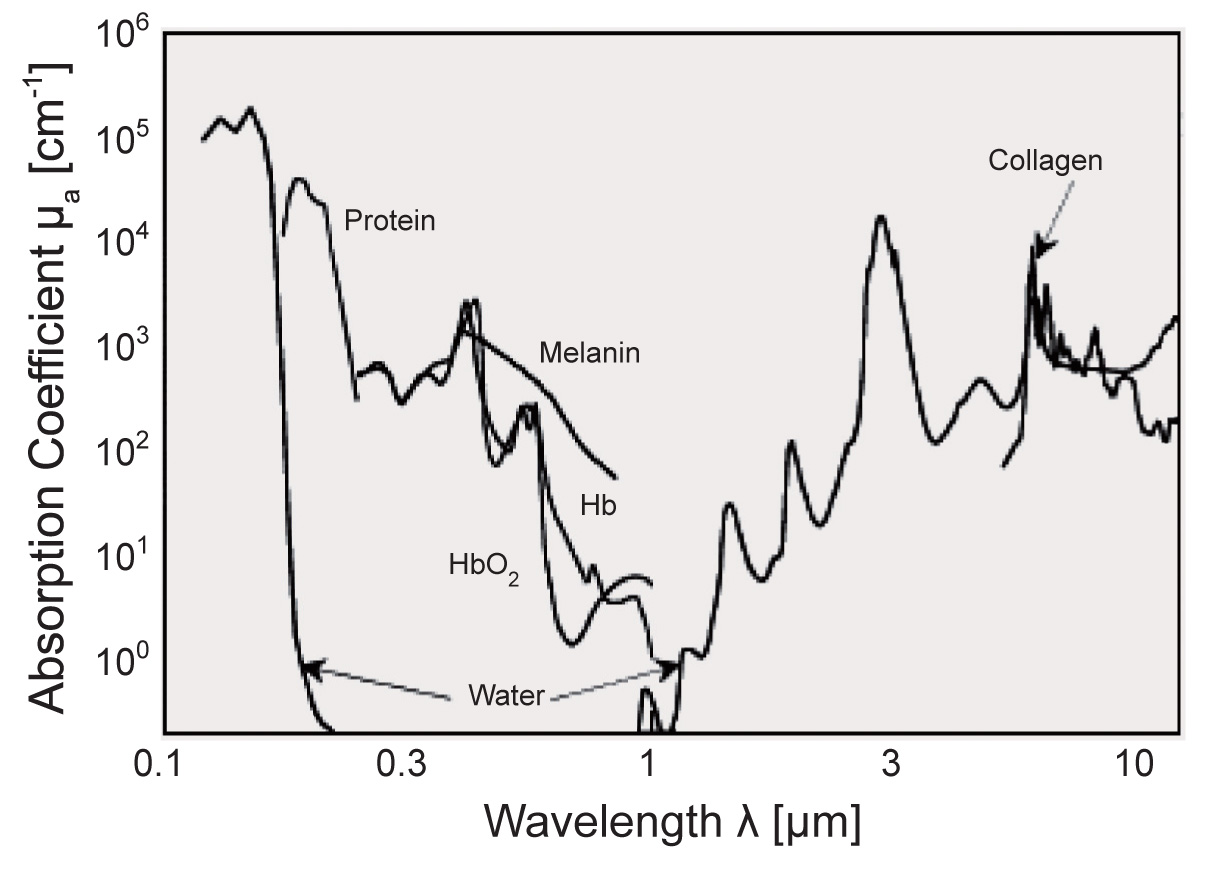5-1. Optical process of energy transfer
Since the development of laser in 1960, it had not been used a lot for medical use as now for about 25 years due to the lack of fundamental understanding on the process of interaction between laser and soft tissue until mid-1980s. It was from 2000s when the subject had rapidly gained attention with more and more studies being published, and now laser has become the basic tool for surgery. Understanding the process would be of much help for appropriate use of medical laser. In order to understand the interaction of laser with soft tissue, it is most important to know what optical process occurs when the skin is irradiated by the laser light. Skin tissues exposed to light undergoes the following 4 optical processes:
1) Absorption
2) Scattering
3) Transmission
4) Reflection
[Advertisement] ▶ HELIOSⅡ/LOTUSⅡ/HYPERION – Manufacturer: LASEROPTEK(www.laseroptek.com)
There are various forms of energy in the nature with different sizes determined by the physical condition. Thermal energy, chemical energy, sound energy, light energy and kinetic energy are the examples.
Among these, laser is a form of light energy which shifts its form when interacting with another material. What is common between medical and industrial lasers is the change in the form of energy by absorption. For example, when welding or cutting a steel plate with laser, the laser is absorbed to the steel plate in the form of light energy and then changes to thermal energy, melting the steel plate for welding or cutting. Likewise, for the treatment of vascular lesions in the face or legs, laser absorbed in the form of light energy should be changed to thermal energy for coagulation or contraction of blood vessels. Thus, without absorption, no physical process can occur. Given the importance of absorption, unfortunately, human skin absorbs different amount of laser depending on the wavelength, causing the hassle of having to choose the laser which emits a wavelength that absorbs well in the lesion to be treated. Figure 2 shows optical absorption coefficients of light-absorbing chromophores. The representative soft tissue components are protein, melanin, hemoglobin, water and collagen.

Figure 1. Optical absorption coefficients of principal tissue chromophores in the 0.1-12 um spectral region.
Absorption means light energy transferring to another form of energy when the light interacts with molecules or atoms. It is difficult to describe accurately the process of which the light is absorbed in the tissue due to the non-uniform and complex structure of skin tissue. This will be described later conceptually with a simple formula.
Scattering refers to the physical process where light is deviated from a straight trajectory by collision with molecules, atoms or particles smaller than the wavelength of light. Scattering occurs in a gas, liquid and solid, although the scattered light more frequently appear as refraction or reflection of light in a solid or liquid. Scattered light appears inside an object (such as in the skin tissue) only when the skin tissue has irregular density or orientation of the arranged molecules. For example, when irradiating a laser light in the visible spectrum to very non-uniform skin tissues, the area near the irradiated site appears bright due to backscatter phenomenon of light. As skin tissues cause much scattering effect to light, the laser light has limited penetration depth without proceeding deeper into the skin. Since the penetration depth also varies depending on the wavelength of light, the wavelength should be selected properly according to the depth of the lesion to be treated. The fluence irradiated on the skin should be increased to obtain a satisfactory therapeutic effect because the fluence per unit area decreases as scattering increases. The penetration depth in the skin becomes greater from visible light to infrared light until reaching the plateau with Nd:YAG laser wavelength (1064nm), after which the depth decreases again.
Transmission is a very important physical property for selective treatment. For example, Q-switched Nd:YAG laser (1064nm wavelength), which is used for pigmented lesions located deep in the dermis layer, is not therapeutic if it is absorbed in the epidermis layer and does not reach the dermis layer. The Q-switched Nd:YAG laser (1064nm wavelength) can be therapeutic because the absorption rate is smaller than the transmission rate in the epidermis layer, while the transmission rate is smaller than the absorption rate in the dermis layer. As every material on earth (including skin tissue) has its own absorption spectrum, selective treatment is available without inflicting damage to the other tissues if only the exact absorption spectrum can be found. This is the unique property of laser light.
Reflection is a physical property that has no interaction with a laser light and has no effect on a therapy. For example, hard tissues, such as enamel, reflect all laser lights from the surface, making it difficult to treat. However, enamel can be treated as well when Er:YAG laser (2940nm) is used with water. This is because the water on the surface becomes rapidly hot by absorbing laser light and then explodes, ablating the enamel layer.
The above-described 4 optical phenomena, absorption in relation to the wavelength of light and energy, scattering in relation to the light penetration depth and fluence, and transmission in relation to selective treatment, should be well understood for better use of medical laser. The links among these properties should be also well understood because they occur simultaneously when irradiating a laser to skin tissues.
5-2. Parameters of lasers
Among the methods of laser oscillation are continuous wave oscillation and pulse oscillation. Most of the current medical lasers adopt the pulse oscillation to minimize thermal damage to surrounding normal tissues. The following parameters are for pulse lasers:
1) Energy
2) Power (P)
3) Beam profile/pattern
4) Pulse duration
These 4 parameters should be considered first when evaluating lasers of the same wavelength.
Energy means the capability of work, or energy transfer between two objects (that is, laser energy delivering energy to skin tissues), and is presented as Joule [J]. The fluence mentioned above when describing scattering refers to energy per unit area [J/cm2]. For example, if output energy is 1 Joule and the diameter of the output beam is 4mm, the area of the output beam is 3.14×0.2×0.2cm2, or approximately 0.13 cm2, and the resulting fluence is 1/0.13=7.7J/cm2. High fluence or energy means greater ability to deliver energy to the skin tissue, or even therapeutic injury of the epithelia beyond certain level of fluence or energy. Therefore, the epithelia should be cooled down properly to minimize thermal injury during a procedure.
Power/P means the amount of work per unit time, or the change of energy per unit time (P=Joule/time), and is presented as W[watt]. Power is represented by average power and peak power. The average power is energy [J] x pulse repletion rates [Hz], while the peak power is energy [J] / pulse duration [s]. For example, when pulse duration is 5ns (5×10-9s), maximum pulse repetition rate is 10Hz and output energy is 1 Joule, the average power is 10W and the peak power is 2×108 W (200MW).
Beam profile is determined by the structure of the laser resonator and there are roughly two types. One is the output from multimode resonator and the other is the output from single-mode resonator. Typically, the laser from single-mode has a bell-shaped Gaussian profile, while the laser from multimode has non-uniform beam profile. It is the dream of laser researchers to design and develop a resonator for flat-top beam profile, which is theoretically impossible. In case of Q-switched high power solid-state laser, the great thermal lens effect of the gain medium – Nd:YAG crystal, for example – makes it impossible to realize flat-top beam profile. Nevertheless, unstable resonator or a resonator which can compensate for the thermal lens effect inside the resonator can be used to produce relatively uniform laser, and these suggestions are often being used in practice.
Pulse duration is the time it takes to generate laser beam. The full width at half maximum on the axis of time is expressed as pulse duration. Lasers can be categorized to long pulse (>1ms), free-running (~tens or hundreds ns), short-pulse (~ns) or ultra-short –pulse (<1ns) depending on the pulse duration. In general, long pulse lasers are used for maximized thermal effect, while short pulse (Q-switched) lasers are used for minimized thermal effect with high peak power.
- To be continued -
▶ Previous Artlcle : #2. Development Process and Types of Lasers
▶ Next Artlcle : #4. Lasers and Soft Tissue Interaction ‖





















